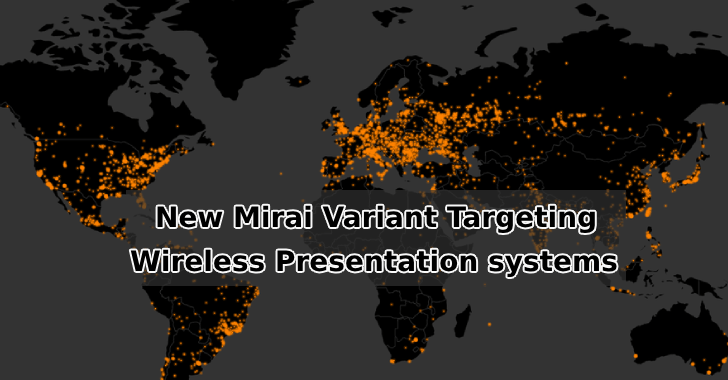Mirai malware is a powerful strain that compromises a number of Linux devices and uses those devices to launch a massive distributed denial of service attacks.
The new malware variant targets embedded devices such as routers, network storage devices, NVRs, and IP cameras and using numerous exploits against them.
According to Unit 42 researchers the malware particularly targets, “WePresent WiPG-1000 Wireless Presentation systems, and in LG Supersign TVs. Both these devices are intended for use by businesses.”
The new version of the Mirai packed with multiple new exploits along with the old ones, it also adds new credentials to launch brute force attacks on targeted devices. The malware especially targets enterprise devices, where they get huge botnets with huge bandwidth.
The new variant of the Mirai malware contains 27 exploits in total, 11 of them from the new version of the Mirai malware.
| Vulnerability | Devices Affected |
|---|---|
| CVE-2018-17173 | LG Supersign TVs |
| WePresentCmdInjection | WePresent WiPG-1000 Wireless Presentation systems |
| DLink DCS-930L Remote Command Execution | DLink DCS-930L Network Video Cameras |
| DLink diagnostic.php Command Execution | DLink DIR-645, DIR-815 Routers |
| Zyxel P660HN Remote Command Execution | Zyxel P660HN-T routers |
| CVE-2016-1555 | Netgear WG102, WG103, WN604, WNDAP350, WNDAP360, WNAP320, WNAP210, WNDAP660, WNDAP620 devices |
| CVE-2017-6077, CVE-2017-6334 | Netgear DGN2200 N300 Wireless ADSL2+ Modem Routers |
| Netgear Prosafe Remote Command Execution | Netgear Prosafe WC9500, WC7600, WC7520 Wireless Controllers |
According to Bad packets following are the ports targeted.
Unit 42 researchers spotted the new variant had some other differentiating features:
- It makes use of the same encryption scheme as is characteristic of Mirai with a table key of 0xbeafdead.
- When decrypting strings using this key, we found certain unusual default credentials for the brute force that we haven’t come across until now:
- admin:huigu309
- root:huigu309
- CRAFTSPERSON:ALC#FGU
- root:videoflow
- It uses the domain epicrustserver[.]cf at port 23823 is for C2 communication.
- In addition to scanning for other vulnerable devices, the new version can be commanded to send out HTTP Flood DDoS attacks.
Mitigation
- Disable features and services that are not required.
- Disable Telnet login and use SSH where possible.
- Disable Universal Plug and Play (UPnP) on routers unless absolutely necessary.
- Perform an audit of IoT devices used on your network.
- Change the default credentials on devices. Use strong and unique passwords for device accounts and Wi-Fi networks.
- Use wired connections instead of wireless, where possible.
- Regularly check the manufacturer’s website for firmware updates.
Related Read








